How to distinguish late blight from other diseases and disorders with similar symptoms
Because late blight is so highly contagious and destructive, it’s important to take an aggressive, community-wide management approach to nip any potential infections in the bud before the disease has a chance to spread. That means inspecting plants regularly and quickly destroying any that show signs of the disease. Then spreading the word to others to be on the lookout. (See Avoid the late blight blues.)
But before you pull up plants that have symptoms that look like late blight, make sure they aren’t one of the ‘imitators’! There are several diseases and disorders with symptoms that could be mistaken for late blight. The most common are below, and you can also view an entire online webinar presentation on the subject.
Click on images to view more (and larger) images of the disease.
Unless you are able to conclude with great certainty that your plants do have one of the other maladies, get help by submitting a sample to a diagnostic clinic. Contact your local Cooperative Extension office for help.
 Late blight. The first step in diagnosis is to examine affected plants thoroughly for symptoms. Don’t stop at the first symptom. Look at other plant parts too. Early in the day is best. The late blight pathogen produces most of its spores at night, so it’s usually more visible in the morning. Late blight can affect all parts whereas some of the ‘imitators’ cannot. Characteristic leaf symptoms are very large spots, which look water-soaked at first then turn brown, often with a border of light green wilted tissue. The best place to look for the white fuzzy growth of spores is on the underside of leaf lesions. Large, dark brown lesions develop on stems and petioles, and sometimes the pathogen sporulates on these, too. When petioles are affected, the whole leaf can collapse. Affected fruit develop large, brown, firm areas.
Late blight. The first step in diagnosis is to examine affected plants thoroughly for symptoms. Don’t stop at the first symptom. Look at other plant parts too. Early in the day is best. The late blight pathogen produces most of its spores at night, so it’s usually more visible in the morning. Late blight can affect all parts whereas some of the ‘imitators’ cannot. Characteristic leaf symptoms are very large spots, which look water-soaked at first then turn brown, often with a border of light green wilted tissue. The best place to look for the white fuzzy growth of spores is on the underside of leaf lesions. Large, dark brown lesions develop on stems and petioles, and sometimes the pathogen sporulates on these, too. When petioles are affected, the whole leaf can collapse. Affected fruit develop large, brown, firm areas.
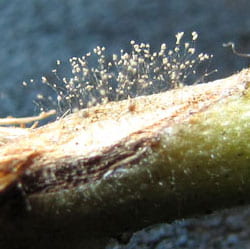 Gray mold. This is the disease most commonly confused for late blight because the pathogen causes large leaf spots, stem lesions, and affects fruit. These symptoms are often associated with dead plant tissue (flowers, leaves). The pathogen typically needs to become established on these dead tissues before it can attack living plant tissue. Affected fruit are soft and are not brown. The pathogen growth is fuzzier and gray to brownish, not white as with late blight.
Gray mold. This is the disease most commonly confused for late blight because the pathogen causes large leaf spots, stem lesions, and affects fruit. These symptoms are often associated with dead plant tissue (flowers, leaves). The pathogen typically needs to become established on these dead tissues before it can attack living plant tissue. Affected fruit are soft and are not brown. The pathogen growth is fuzzier and gray to brownish, not white as with late blight.
Leaf mold. Spots on leaves are the primary symptom. They are smaller than typical late blight lesions and lack a distinct margin. Color of leaf mold spots on upper leaf surfaces progresses from pale green to yellow. And most notably for distinguishing this disease from late blight, the causal pathogen produces spores that initially are greenish gray to brown, becoming darker brown with age and developing a velvety appearance. Spores are produced on the underside of leaves. The late blight pathogen produces white spores.
Spots on leaves are the primary symptom. They are smaller than typical late blight lesions and lack a distinct margin. Color of leaf mold spots on upper leaf surfaces progresses from pale green to yellow. And most notably for distinguishing this disease from late blight, the causal pathogen produces spores that initially are greenish gray to brown, becoming darker brown with age and developing a velvety appearance. Spores are produced on the underside of leaves. The late blight pathogen produces white spores.
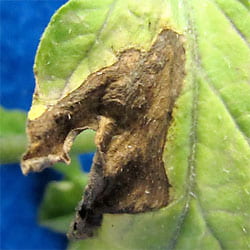 Drought stress. When plants’ roots cannot deliver enough water to leaves, large sections of leaf tissue can die. In contrast with late blight lesions, symptoms of drought stress always extend from the leaf edge, they lack a border of wilted tissue, and there is no fuzzy pathogen growth. Also, no symptoms develop on stems or fruit. Under some circumstances, late blight can be more difficult to distinguish from drought stress. View images of late blight that resemble drought stress from July 2011 heat wave.
Drought stress. When plants’ roots cannot deliver enough water to leaves, large sections of leaf tissue can die. In contrast with late blight lesions, symptoms of drought stress always extend from the leaf edge, they lack a border of wilted tissue, and there is no fuzzy pathogen growth. Also, no symptoms develop on stems or fruit. Under some circumstances, late blight can be more difficult to distinguish from drought stress. View images of late blight that resemble drought stress from July 2011 heat wave.
 Bacterial canker. Sometimes canker causes large areas of leaf tissue to die without the characteristic yellow border for this disease. Affected tissue always extends from the leaf margin whereas late blight can cause spots in the center part of leaves.
Bacterial canker. Sometimes canker causes large areas of leaf tissue to die without the characteristic yellow border for this disease. Affected tissue always extends from the leaf margin whereas late blight can cause spots in the center part of leaves.
Early blight.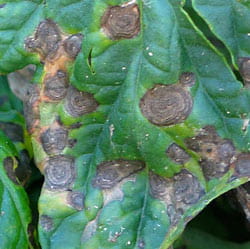 Leaf, stem and fruit spots are all smaller than with late blight and often have a characteristic concentric ring pattern or target-shape appearance.
Leaf, stem and fruit spots are all smaller than with late blight and often have a characteristic concentric ring pattern or target-shape appearance.
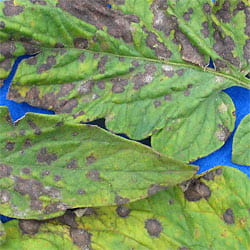 Septoria leaf spot. Leaf and stem spots are all much smaller than with late blight and often have a characteristic tan center. Fruit are not affected.
Septoria leaf spot. Leaf and stem spots are all much smaller than with late blight and often have a characteristic tan center. Fruit are not affected.
Buckeye fruit rot.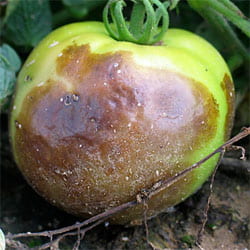 Fruit turns brown with white spores forming when moist. Unlike late blight, buckeye fruit rot is most likely on fruit on or near the soil where the pathogen can survive between crops, the fruit stays firm and smooth (not rough) and leaves and stems are not affected. Causal pathogens are closely related to late blight, but don’t travel far or fast because their spores move by splashing water and soil, rather than air.
Fruit turns brown with white spores forming when moist. Unlike late blight, buckeye fruit rot is most likely on fruit on or near the soil where the pathogen can survive between crops, the fruit stays firm and smooth (not rough) and leaves and stems are not affected. Causal pathogens are closely related to late blight, but don’t travel far or fast because their spores move by splashing water and soil, rather than air.


